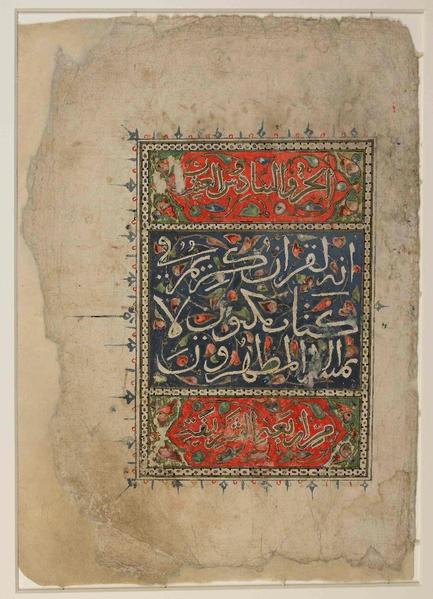 1
1title: Folio from a Khamsa (Quintet) of Amir Khusraw Dihlavi; Majnun throwing himself onto Layla's grave Google Art Project
artist:
Unknown authordate: circa 1450
medium: Ink and color on paper
dimensions: w229 x h340 cm
current location: Freer Gallery of Art, Smithsonian
credit: HQHGzOj_kjH2mQ at Google Cultural Institute maximum zoom level
license:Public domain
 2
2title: Antiquities of Samarkand. Tomb of the Saint Kusam-ibn-Abbas (Shah-i Zindah) and Adjacent Mausoleums. Grave Where the Sepulcher of the Saint Stands. Grave of the Saint Kusam-ibn-Abbas (Shah-i Zindah) Who Died in 57 A.H.
artist: Shostak, L. A.
date: between 1871 and 1872
medium: ru 1=Эстампы, фотографии fr 1=Images, photographies en 1=Prints, Photographs zh 1=图像, 摄影作品 pt 1=Imagens, Fotografias ar 1=مطبوعات، صور فوتوغرافية es 1=Imágenes, Fotografías
dimensions: en 1=1 drawing : watercolor
current location: ru|1=Библиотека Конгресса fr|1=Bibliothèque du Congrès en|1=Library of Congress zh|1=国会图书馆 pt|1=Biblioteca do Congresso ar|1=مكتبة الكونغرس es|1=Biblioteca del Congreso
description: This sketch of the interior of the Kusam-ibn-Abbas Mausoleum in the northern cluster of shrines at the Shah-i Zindah necropolis in Samarkand is from the archeological part of Turkestan Album. The six-volume photographic survey was produced in 1871-72, under the patronage of General Konstantin P. von Kaufman, the first governor-general (1867-82) of Turkestan, as the Russian Empire's Central Asian territories were called. The album devotes special attention to Samarkand’s islamic architecture, such as 14th- and 15th-century monuments from the reign of Timur (Tamerlane) and his successors. The Shah-i Zindah (Persian for “living king”) ensemble is revered as a memorial to Kusam-ibn-Abbas, a cousin of the Prophet Muhammad. He is considered by believers to be buried at this site, after being killed in an Arab attack in 673. The part of the mausoleum known as the gurkhana, or sepulcher, is believed to contain his tomb. The sketch gives outlines of the walls, while the foreground shows the stepped sarcophagus (early 14th century), richly decorated with majolica tiles. In addition to floral ornamentation, the surface displays the inscription: “Never consider dead those who are killed on the path to Allah. No, they are alive!” Also noted is the year 57 A.H. (the islamic calendar), or 676-77 C.E. The sketch is signed by the artist, L.A. Shostak.
Kusam-ibn-Abbas; Sarcophagi; Sepulchral monuments; Shāh-i Zindahlicense:Public domain
 3
3title: Antiquities of Samarkand. Mosque of Khodzha Akhrar. Bottom. Inscription on the Tombstone at the Grave of Khodzha Akhrar
artist: Bogaevskii, Nikolai V., 1843-1912
date: between 1868 and 1872
medium: ru 1=Эстампы, фотографии fr 1=Images, photographies en 1=Prints, Photographs zh 1=图像, 摄影作品 pt 1=Imagens, Fotografias ar 1=مطبوعات، صور فوتوغرافية es 1=Imágenes, Fotografías
dimensions: en 1=1 photographic print : albumen
current location: ru|1=Библиотека Конгресса fr|1=Bibliothèque du Congrès en|1=Library of Congress zh|1=国会图书馆 pt|1=Biblioteca do Congresso ar|1=مكتبة الكونغرس es|1=Biblioteca del Congreso
description: This photograph of the interior of the Khodzha Akhrar shrine in Samarkand (Uzbekistan) is from the archeological part of Turkestan Album. The six-volume photographic survey was produced in 1871-72 under the patronage of General Konstantin P. von Kaufman, the first governor-general (1867-82) of Turkestan, as the Russian Empire’s Central Asian territories were called. The album devotes special attention to Samarkand’s islamic architectural heritage. Seen here is the bottom half of the tombstone at the grave of Khodzha Akhrar (1403-89), a renowned 15th-century mystic, ascetic, and adherent of Sufism who wielded great spiritual influence in Central Asia during the final decades of the Timurid dynasty. He is said to have established mosques not only in Samarkand, but also in Bukhara, Herat, and Kabul. The Khodzha Akhrar ensemble in Samarkand contained several structures, including a winter and a summer mosque, as well as a cemetery. Located inside the mosque, the grave marker is framed by a carved inscription band in elaborate cursive Perso-Arabic script. As with the upper half of the stone, the main part of the surface is recessed and consists of further inscriptions related to the life of the saint. This extraordinary display of carved text is an indication of the importance of the Khodzha Akhrar shrine as a pilgrimage site.
Inscriptions; islamic architecture; Mosques; Photographic surveys; Sepulchral monuments; Tombslicense:Public domain
 4
4title: Antiquities of Samarkand. Mosque of Khodzha Akhrar. Top. Inscription on the Tombstone at the Grave of Khodzha Akhrar
artist: Bogaevskii, Nikolai V., 1843-1912
date: between 1868 and 1872
medium: ru 1=Эстампы, фотографии fr 1=Images, photographies en 1=Prints, Photographs zh 1=图像, 摄影作品 pt 1=Imagens, Fotografias ar 1=مطبوعات، صور فوتوغرافية es 1=Imágenes, Fotografías
dimensions: en 1=1 photographic print : albumen
current location: ru|1=Библиотека Конгресса fr|1=Bibliothèque du Congrès en|1=Library of Congress zh|1=国会图书馆 pt|1=Biblioteca do Congresso ar|1=مكتبة الكونغرس es|1=Biblioteca del Congreso
description: This photograph of the interior of the Khodzha Akhrar shrine in Samarkand (Uzbekistan) is from the archeological part of Turkestan Album. The six-volume photographic survey was produced in 1871-72 under the patronage of General Konstantin P. von Kaufman, the first governor-general (1867-82) of Turkestan, as the Russian Empire’s Central Asian territories were called. The album devotes special attention to Samarkand’s islamic architectural heritage. Seen here is the tombstone at the grave of Khodzha Akhrar (1403-89), a renowned 15th-century mystic, ascetic, and adherent of Sufism who wielded great spiritual influence in Central Asia during the final decades of the Timurid dynasty. He is said to have established mosques not only in Samarkand, but also in Bukhara, Herat, and Kabul. The Khodzha Akhrar ensemble in Samarkand contained several structures, including a winter and a summer mosque, as well as a cemetery. Located in the mosque, this grave marker is framed by a carved inscription band in elaborate cursive Perso-Arabic script. The central part of the surface is recessed and consists of further inscriptions framed by a pointed arch decorated with botanical figures and surmounted with an eight-pointed star. Above the arch point is a corbelled “stalactite” element supporting the main sacred inscription. The Khodzha Akhrar shrine was an important pilgrimage site.
Inscriptions; islamic architecture; Mosques; Photographic surveys; Sepulchral monuments; Tombslicense:Public domain
 5
5title: Zeravshan Okrug. Tomb of Saint Makhmud Azam in the Village of Dakhbit
artist: Bogaevskii, Nikolai V., 1843-1912
date: between 1865 and 1872
medium: ru 1=Эстампы, фотографии fr 1=Images, photographies en 1=Prints, Photographs zh 1=图像, 摄影作品 pt 1=Imagens, Fotografias ar 1=مطبوعات، صور فوتوغرافية es 1=Imágenes, Fotografías
dimensions: en 1=1 photographic print : albumen
current location: ru|1=Библиотека Конгресса fr|1=Bibliothèque du Congrès en|1=Library of Congress zh|1=国会图书馆 pt|1=Biblioteca do Congresso ar|1=مكتبة الكونغرس es|1=Biblioteca del Congreso
description: This photograph of the grave shrine (mazar) of Hodja Mahmud Azam in the village of Dakhbit (Uzbekistan) is from the archeological part of Turkestan Album. The six-volume photographic survey was produced in 1871-72 under the patronage of General Konstantin P. von Kaufman, the first governor-general (1867-82) of Turkestan, as the Russian Empire’s Central Asian territories were called. Dakhbit was located in Zeravshan District (okrug), formed as part of the Russian Empire in 1868 when Russian troops occupied the eastern part of the Khanate of Bukhara (present-day Uzbekistan). By the end of 1868, the area around the town of Pendzhikent (present-day Panjakent, in northwest Tajikistan) was added to the district. By 1871 the district had absorbed fiefdoms in the upper reaches of the Zeravshan River, a tributary of the Amu Darya. “Dakhbit” is considered a Tajik toponym in an area inhabited by both Uzbek and Tajik peoples. The creation of shrines at the graves of revered religious figures was a widespread practice in Central Asia. In some cases the shrine could be an imposing mausoleum (mazar) or a pilgrimage center (khanaka). Here the shrine is more modest and consists of the central tomb, a retaining wall, and other graves. The large poplar tree in the foreground contains stork nests.
Archaeological sites; islamic architecture; Photographic surveys; Sepulchral monuments; Tombslicense:Public domain
 6
6title: Zeravshan Okrug. Shrine of Saint Khodzha Chinar in Urgut
artist: Bogaevskii, Nikolai V., 1843-1912
date: between 1865 and 1872
medium: ru 1=Эстампы, фотографии fr 1=Images, photographies en 1=Prints, Photographs zh 1=图像, 摄影作品 pt 1=Imagens, Fotografias ar 1=مطبوعات، صور فوتوغرافية es 1=Imágenes, Fotografías
dimensions: en 1=1 photographic print : albumen
current location: ru|1=Библиотека Конгресса fr|1=Bibliothèque du Congrès en|1=Library of Congress zh|1=国会图书馆 pt|1=Biblioteca do Congresso ar|1=مكتبة الكونغرس es|1=Biblioteca del Congreso
description: This photograph of the grave shrine (mazar) of the holy Khodzha Chinar in the town of Urgut (Uzbekistan) is from the archeological part of Turkestan Album. The six-volume photographic survey was produced in 1871–72 under the patronage of General Konstantin P. von Kaufman, the first governor-general (1867–82) of Turkestan, as the Russian Empire’s Central Asian territories were called. Urgut was located in Zeravshan District (okrug), formed as part of the Russian Empire in 1868 when Russian troops occupied the eastern part of the Khanate of Bukhara (in present-day Uzbekistan). By the end of 1868, the area around the town of Pendzhikent (present-day Panjakent, in northwest Tajikistan) was added to the district. By 1871 the district had absorbed fiefdoms in the upper reaches of the Zeravshan River, a tributary of the Amu Darya. The creation of shrines at the graves of revered religious figures was a widespread practice in Central Asia. In some cases the shrine could be an imposing mausoleum (mazar) or a pilgrimage center (khanaka). This shrine, in a state of disrepair, is constructed simply of adobe brick with little decoration.
Archaeological sites; islamic architecture; Photographic surveys; Sepulchral monuments; Shrines; Tombslicense:Public domain
 7
7title: Qur'anic Verses (56:77-9) on Carpet Page
artist: unknown
date: between 1300 and 1499
medium: ru 1=Рукописи fr 1=Manuscrits en 1=Manuscripts zh 1=手稿 pt 1=Manuscritos ar 1=مخطوطات es 1=Manuscritos
dimensions: en 1=20 x 30.2 centimeters
current location: ru|1=Библиотека Конгресса fr|1=Bibliothèque du Congrès en|1=Library of Congress zh|1=国会图书馆 pt|1=Biblioteca do Congresso ar|1=مكتبة الكونغرس es|1=Biblioteca del Congreso
description: As noted in the red rectangular registers at the top and bottom of this inscribed panel, this folio introduces the 26th juz' (section) of the Qur'an. The central space includes an inscription containing verses 77–79 of Chapter 56, Surat al-Waqi'ah (The inevitable). These verses typically open the Qur'an, although they may appear in decorated pages used to separate the ajza' (parts) of the Qur'an. The surah (chapter) title at the top is executed in gold and outlined in black ink. It specifies that this surah contains 35 verses, while the fragment’s recto introduces the 26th section, of which it constitutes the first chapter. The fragment’s verso includes verses 1–3 of Chapter 46, Surat al-Ahqaf (The winding sand tracts). The script is thuluth, a cursive script typical of the Mamluk period (14th–15th centuries) in Egypt. The background of spiral scrollwork on this decorative page is characteristic of Qur'ans of this period. This chapter is the seventh and last of the ha-mim series (chapters 40–46). It argues that all Creation has a divine purpose. For this reason, the righteous must wait with patience, as Truth and Revelation will be vindicated. The ha-mim letters are the mystery or abbreviated letters, appearing singly or in combination at the beginning of certain chapters in the Qur'an. The juz' marker forms an artistic break in the Qur'an. The inscriptions at the top and bottom are executed in gold ink in a black calligraphic outline inscribed on the cream-colored page, placed on a red background with arabesques of blue and green leaves.
Arabic calligraphy; Illuminations; islamic calligraphy; islamic manuscripts; Koranlicense:Public domain
 8
8title: Thesis on the Mirror of the Hearts
artist: I︠A︡savi, Akhmed, died 1166
date: between 1700 and 1800
medium: ru 1=Рукописи fr 1=Manuscrits en 1=Manuscripts zh 1=手稿 pt 1=Manuscritos ar 1=مخطوطات es 1=Manuscritos
current location: ru|1=Национальная библиотека Казахстана fr|1=Bibliothèque nationale du Kazakhstan en|1=National Library of Kazakhstan zh|1=哈萨克斯坦国家图书馆 pt|1=Biblioteca Nacional do Cazaquistão ar|1=المكتبة الوطنية لكازاخستان es|1=Biblioteca Nacional de Kazajstán
description: Khodzha Akhmed Iassavi (died 1166) was a philosopher, Sufi mystic, and the earliest known poet to write in a Turkic dialect. He was born in the city of Isfijab (present-day Sayram, in Kazakhstan) but lived most of his life in Turkestan (also in southern Kazakhstan). He was a student of Arslan Baba, a well-known preacher of Islam. At a time when Farsi dominated literature and public life, Iassavi wrote in his native Old Turkic (Chagatai) language. He was known during his lifetime as a holy person and people from all parts of Central Asia came to revere him. He spent the last years of his life in an underground cell called the khalwat. Later the grave of Khodzha Akhmed Iassavi became a destination for pilgrims and a UNESCO World Heritage site. Risālat mira’āt al-qulūb (Thesis on the mirror of the hearts) is a philosophical work with a preface by the 18th-century copyist. While Iassavi’s famous book Divan-i hikmet (Anthology of wisdom) contained poems, this work, promoting postulates of Islam, was written in prose. This book describes the principle provisions of sharia (islamic law), including the main rules and beliefs of Islam and the humanistic values of justice, honesty, and kindness.
islamic law; islamic manuscripts; islamic philosophy; Sufismlicense:Public domain
 9
9title: Grave of Sheikh Ibn Moelana
artist: Matthijs Balen
date: 1724
medium: nl 1=gravure op papier en 1=engraving on paper
dimensions: Size unit=cm width=31.5 height=19.4
current location: Institution:Koninklijke Bibliotheek
source: Atlas of Mutual Heritage|institute=kb [link Source at the Atlas of Mutual Heritage] |notes=en|1='''Subjects''': gravestone, flora, Person, European, Asians & Africans, survey / view, banderole / cartouche / ornamentation, cemetery / graveyard, building, fence / kraal nl|1='''Onderwerpen''': grafsteen / grafzerk, flora, Persoon, Europeanen, Aziaten & Afrikanen, overzicht / aanzicht, banderol / cartouche / versiering, begraafplaats / kerkhof, gebouw, omheining / kraal en|1='''Post''': this image is related to a WIC trading post called [link ''Cirebon'']
credit: This is an image from the Atlas of Mutual Heritage and the Koninklijke Bibliotheek, the Dutch National Library.
The metadata of this file is public domain under a Creative Commons Public Domain Dedication (CC-ZERO). This permission has been archived as ticket #2014051410008887
description: grave of Sheikh Ibn Moelana. -Graf-Stede van Sjeich Ibn Moelana.
Top left: E.
The plate is taken from the work 'Oud en Nieuw Oost-Indien' by Francois Valentyn.
The mausoleum was situated a short distance north of Cheribon.
According to Valentyn Sheikh Ibn Moelana was one of the most important disseminators of the islamic faith on Java.
Cf. Koninklijke Bibliotheek, The Hague, inv. nr. 693 C 6 dl XVII, after p. 266.license:Public domain

title: Collectie NMvWereldculturen, TM 3500-313c, Kalender van 1963. Josephine Powell Collection, 1963
artist: unknown
date: 1963
medium: nl 1=''Materiaal'':papier (vezelproduct) ; ''Techniek'':vlakdrukprocedés
dimensions: 76 x 51cm (29 15/16 x 20 1/16in.)
current location: Institution:Nationaal Museum van Wereldculturen
source: [link View this image on the website of the Nationaal Museum van Wereldculturen]
credit: View this image on the website of the Nationaal Museum van Wereldculturen
description: islamic calendar for the year 1963. This corresponds with the year 1382-83 of the islamic era (hijri) and 2019-20 of the Sikh era (bikrami), as the calendar indicates. The calendar shows the mausoleum of imam Ali (d. 661), the founder of the Shiite movement within Islam, in Najaf (Iraq). Below the picture of the mausoleum is the calendar of 1963 with the months and days in both English and Urdu. In the frame above the picture is a text in Urdu. At the picture itself is written in Arabic: "The blessed resting place of the pastor [imam] of the faithful, the holy Ali (al-murtadha), may God's blessing be with him in the noble Najaf, Iraq". For Shiites not only the pilgrimage to Mecca, but also a visit to the grave of one of the imams, like the grave of Ali in Najaf (Iraq), is in high esteem. Collected by w:Josephine Powell.
license:
CC BY 4.0





